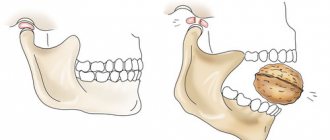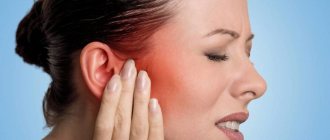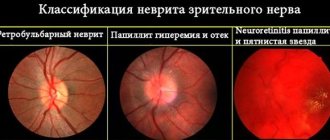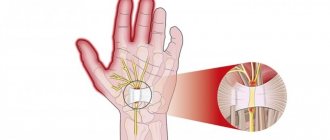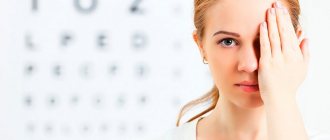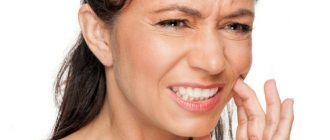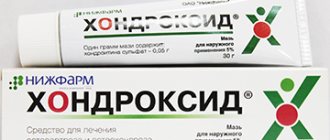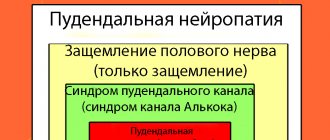Causes
The patient experiences unbearable pain when the trigeminal nerve is compressed by a vascular loop, veins/arteries of the posterior cranial fossa. Some patients with trigeminal neuralgia have excessive pressure in the bone canals at the base of the skull, where part of the nerve is located.
Main reasons:
- congenital pathologies;
- inflammatory diseases of a chronic nature in nearby areas. Most often - sinusitis, deep caries, sinusitis.
Possible complications
Without proper and timely treatment of pathologies of the jaw joint, severe complications develop that negatively affect speech and chewing functions.
Consequences:
- arthritis;
- bursitis;
- complete immobilization of the lower jaw - ankylosis, occurs after fractures and with advanced infectious pathologies;
- destruction of the structural parts of the joint is a consequence of staphylococcal and streptococcal infections;
- deterioration of hearing, vision;
- constant migraine attacks, pain in the jaw muscles;
- meningitis - inflammation of the membranes of the brain when the infection spreads along the ascending pathways;
- sepsis.
In chronic and advanced diseases, bone and cartilage tissue begins to deteriorate, teeth are destroyed and mixed together. All this only makes the situation worse.
Exercises for TMJ pain:
Types and classification
Depending on the time of development of inflammation, two types of neuralgia are distinguished:
- congenital;
- acquired.
What is a rubber dam in dentistry and in what cases is the device used? We have the answer!
For a review of effective gels and ointments for bleeding and gum inflammation, see this page.
Depending on the area of pain, a certain type of nerve damage is diagnosed:
- unilateral neuralgia;
- bilateral neuralgia.
The odontogenic variety is a dangerous pathology with persistent pain. The nature of the disease is persistent, with significant pain. The cause of damage to nerve endings is problems with periodontal and periodontal tissues, advanced stages of caries, chronic inflammation of the nasopharynx.
Note! Even when the underlying disease is cured, excruciating pain in the facial area continues for a long period.
Blown jaw symptoms
- Symptoms and treatment of arthrosis of the hip joint, the essence of the disease
Characteristics of osteoarthritis of the knee joint: causes, symptoms, treatment
Of course, such a diagnosis as “blown shoulder” does not exist in medicine. This condition is called myositis and is quite common. The main reasons are prolonged exposure to a draft or severe hypothermia.
This condition can develop at any age, in both women and men. The symptoms will always be the same, regardless of the location of the development of myositis.
Causes
The main cause of myositis is hypothermia or prolonged exposure to a draft. Moreover, you can get sick in the summer, for example, when working in a room with an air conditioner that is turned on at full power.
Hypothermia can also occur when walking in windy weather or working near an open window. Often the shoulder and neck get blown in the summer after sleeping under a constantly running fan.
Another provoking factor is wearing clothes that are not appropriate for the weather. This is especially true in windy and rainy weather.
Other risk factors include:
- Presence of osteochondrosis.
- Intoxication of the body.
- Intervertebral hernia.
- Arthrosis of the vertebrae.
- Cramps while swimming.
How it manifests itself
The symptoms of a blown shoulder are difficult to confuse with any other diseases of the musculoskeletal system. The first thing the patient will notice is the severe pain that appears in the morning when trying to get out of bed.
This is due to the fact that at night the inflamed muscles begin to compress the nerve fibers. This is where pain and all other unpleasant phenomena come from. The disease develops acutely and completely suddenly for a person against the background of general health. Mostly, attacks of pain occur in the morning after sleep.
Other symptoms include increased pain when pressing or moving, as well as lack of symmetry. That is, myositis usually occurs on one side. There is irradiation of pain to other parts of the body - the back of the head, lower back, shoulder blade, neck. This will depend on which muscle group is inflamed and how severely.
Local symptoms are also present:
- Redness of the skin.
- Edema.
- Stiffness.
- Feeling of tension.
- Local increase in temperature.
Sometimes there may be an enlargement of the lymph nodes that are located in the armpit.
Classification
Before answering the question of how to treat if your shoulder is blown out, you should familiarize yourself with the existing classification. The first, and quite popular type is infectious non-purulent. It occurs in diseases such as influenza, enterovirus, brucellosis, tuberculosis. It is treated only in specialized hospitals.
Acute purulent develops against the background of osteomyelitis. It is also treated only in a hospital, like the underlying disease.
Ossificans occurs after injury, especially if there is deposition of calcium salts in the connective tissue.
How to get rid
What to do if your shoulder blows out? First of all, visit a doctor who will help make an accurate diagnosis and prescribe treatment. It is important to understand what caused the disease and be sure to eliminate them. Only then can the disease be considered cured.
Bed rest and warming procedures are required. Among the drugs to relieve pain and inflammation, those that belong to the NSAID group are prescribed - ketonal, nurofen, diclofenac, ortofen. Sometimes they are recommended to be used in the form of ointments or gels, but if such treatment does not help within 5 days, then the medicine is prescribed in the form of tablets. In severe cases, an injection solution is used.
The doctor may also recommend using warming ointments, the most popular of which are finalgon, apisatron, and nicoflex. In addition to the analgesic and warming effect, they help relieve muscle tension.
How to relieve pain if your shoulder is blown and your temperature rises? In this case, antipyretic drugs, such as paracetamol or ibuprofen, are recommended.
But medications are only part of a comprehensive treatment. Other methods include massage, physical therapy, gymnastics and physiotherapy. Each of them has its own contraindications, which means you should definitely consult your doctor.
In addition to using ointments and gels, novocaine blockades can be used for rubbing. But their effectiveness is not so long-lasting and the pain appears again after a couple of hours.
If purulent myositis has been diagnosed, then surgical treatment cannot be avoided. In this case, the formed purulent focus is removed, and then antibiotics are prescribed.
If your shoulder is blown, how to treat it at home? You should know that only the initial manifestations of the disease can be treated at home. In addition to the remedies prescribed by your doctor, you can use a decoction or infusion of chamomile, always warm the affected area and rub it with pain-relieving ointments.
- Scientists have proven the high effectiveness of manuka honey
- Manifestations and treatment of ankle ankylosis
- Correct posture with 4 simple exercises
- What to do if ankle pain makes it difficult to walk?
- Causes of development and treatment of nagging pain in the legs at night
- Arthrosis and periarthrosis
- Pain
- Video
- Spinal hernia
- Dorsopathy
- Other diseases
- Spinal cord diseases
- Joint diseases
- Kyphosis
- Myositis
- Neuralgia
- Spinal tumors
- Osteoarthritis
- Osteoporosis
- Osteochondrosis
- Protrusion
- Radiculitis
- Syndromes
- Scoliosis
- Spondylosis
- Spondylolisthesis
- Products for the spine
- Spinal injuries
- Back exercises
- This is interesting
- January 29, 2019
- There is an MRI report - what treatment can there be?
- Walking and sitting with a fractured appendage - will this worsen the situation?
- Shoulder pain - what can you recommend?
- Is it possible to take a break when administering ampoules A and B of Dona?
- How should such MRI signs be treated?
January 28, 2019
January 27, 2019
January 26, 2019
January 25, 2019
Directory of clinics for spine treatment
List of drugs and medicines
© 2013 — 2020 Vashaspina.ru | Sitemap | Treatment in Israel | Feedback | About the site | User Agreement | Privacy Policy The information on the site is provided solely for popular information purposes, does not claim to be reference or medical accuracy, and is not a guide to action. Do not self-medicate. Consult your healthcare provider. The use of materials from the site is permitted only if there is a hyperlink to the site VashaSpina.ru.
Symptoms
It is not difficult to recognize the disease: a pronounced form of pain significantly worsens the quality of life. The patient only thinks about how to prevent a new attack.
With trigeminal neuralgia, one or, more often, several signs of a pathological process appear:
- unbearable pain affects one or both sides of the face;
- attacks of acute, shooting pain last 1–2 or several seconds;
- the patient feels a strong lumbago, similar to an electric shock, in the left or right half of the face;
- painful attacks appear within one to two days or torment a person with a certain frequency for up to several months;
- stabbing/shooting pain occurs spontaneously or under the influence of certain irritants: brushing teeth, inhaling a stream of cold air, during an active conversation with expressive facial expressions;
- severe discomfort and pain affect areas controlled by the trigeminal nerve: gums, teeth, jaws, cheeks. Less commonly, lumbago is felt in the eyes and forehead area.
A serious illness has a characteristic symptom - short-term and paroxysmal pain. If you notice that a toothache appears for a few seconds, then disappears, or appears again under the influence of certain irritants, make an appointment with a dentist and neurologist as soon as possible.
Stop deceiving yourself
Before reading further, I will ask you one question: are you still looking for a magic device that can restore your joints the first time, or are you hoping for the Russian “maybe it will blow through”?
Some people soothe the pain with anti-inflammatory, pain-relieving tablets, ointments from advertising, and put blockades, but this does not cure the joints.
The only remedy that will somehow help is Arthropant.
“+”ipt>(adsbygoogle = window.adsbygoogle || []).push({});”+”ipt>
(function(w, d, n, s, t) { w = w || []; w.push(function() { Ya.Context.AdvManager.render({ blockId: 'RA-145897-36', renderTo : 'yandex_rtb_R-A-145897-36', async: true }); }); t = d.getElementsByTagName('script'); s = d.createElement('script'); s.type = 'text/javascript '; s.src = '//an.yandex.ru/system/context.js'; s.async = true; t.parentNode.insertBefore(s, t); })(this, this.document, 'yandexContextAsyncCallbacks '); (function(w, d, n, s, t) { w = w || []; w.push(function() { Ya.Context.AdvManager.render({ blockId: 'RA-145897-30', renderTo : 'yandex_rtb_R-A-145897-30', async: true }); }); t = d.getElementsByTagName('script'); s = d.createElement('script'); s.type = 'text/javascript '; s.src = '//an.yandex.ru/system/context.js'; s.async = true; t.parentNode.insertBefore(s, t); })(this, this.document, 'yandexContextAsyncCallbacks ');
(function(w, d, n, s, t) { w = w || []; w.push(function() { Ya.Context.AdvManager.render({ blockId: 'RA-145897-19', renderTo : 'yandex_rtb_R-A-145897-19', async: true }); }); t = d.getElementsByTagName('script'); s = d.createElement('script'); s.type = 'text/javascript '; s.src = '//an.yandex.ru/system/context.js'; s.async = true; t.parentNode.insertBefore(s, t); })(this, this.document, 'yandexContextAsyncCallbacks '); (function(w, d, n, s, t) { w = w || []; w.push(function() { Ya.Context.AdvManager.render({ blockId: 'RA-145897-22', renderTo : 'yandex_rtb_R-A-145897-22', async: true }); }); t = d.getElementsByTagName('script'); s = d.createElement('script'); s.type = 'text/javascript '; s.src = '//an.yandex.ru/system/context.js'; s.async = true; t.parentNode.insertBefore(s, t); })(this, this.document, 'yandexContextAsyncCallbacks ');(adsbygoogle = window.adsbygoogle || []).push({});
Development of the disease
Trigeminal neuralgia has a characteristic clinical picture:
- The main category of patients is over 50 years old. Sometimes dangerous symptoms develop in people aged 30–35 years, less often - after 25 years;
- Many patients in the neurological and dental departments have a history of the following problems: hypothermia of the face, sinusitis, sinusitis, dental diseases;
- neuralgia does not occur without a reason. Tooth decay due to caries, untreated pulpitis, advanced forms of nasopharyngeal diseases can lead to inflammation of the trigeminal nerve with all the ensuing consequences;
- the first signs of neuralgia appear in the area of a dilapidated unit of the dentition or in the gum area. Often, the dentist removes a healthy tooth, mistakenly believing that it is this problematic unit that provokes painful attacks;
- gradually the pain spreads to new areas. Painful attacks occur with any action in the facial area: talking, sneezing, coughing, facial movements;
- hygiene procedures turn into torture, a person is afraid to wash his face, open his mouth too much, or shave. The patient prepares only liquid meals for himself, often expressing himself in writing in order to minimize the work of facial muscles;
- During attacks, pain literally paralyzes the face. The person is afraid to move, sometimes pressing on his temple or cheek, trying to relieve the pain with an antagonistic gesture;
- often stunning pain is accompanied by lacrimation, mucous secretion from the nasal passages, and redness of the facial skin;
- a painful tic is accompanied by a spasm of the facial muscles. The area of the cheek or eye “freezes,” or the problem spreads over a large area.
Why does pathology appear?
Arthritis of the TMJ appears for various reasons; their occurrence is influenced by various provoking factors:
| Causes | Provoking factors |
| Injuries | Excessive load |
| Infections (from tuberculosis to osteomyelitis) | Hypothermia |
| Metabolic disorder (gout) | Genetic predisposition |
| Autoimmune, systemic diseases (rheumatism, systemic vasculitis) | Stress |
| Malignant neoplasms | Disadvantages of jaw treatment (poor-quality dentures affecting the bite of crowns and fillings) |
| Congenital defects in the formation of maxillofacial bones | Teeth grinding (involuntary, for example during sleep) |
The most common malocclusions
Rules and methods of treatment
It is not easy to alleviate suffering and rid the patient of dangerous symptoms. Some patients suffer from trigeminal neuralgia for many years. Therapy does not always bear fruit; treatment is long-term and sometimes ineffective. Even after filling all the carious cavities and eliminating nasopharyngeal problems, pain does not leave the facial area for a long time.
Find out effective methods for treating chronic periodontitis in children.
Possible complications and consequences of tooth depulpation are described on this page.
Follow the link and read about the beneficial properties and use of sage decoction for oral diseases.
Main measures of maintenance therapy:
- The first stage is to eliminate the causes that caused the damage to the trigeminal nerve. The patient is obliged to treat sinusitis, deep caries, and get rid of nasopharyngeal pathologies;
- antiepileptic drugs alleviate suffering: Stazepine, Carbamazepine, Morfolep, Sodium Valproate, Clonazepam;
- It is mandatory to take B vitamins, which normalize the functioning of peripheral nerves and eliminate spasms. Vitamins B12 and B1 are effective;
- with the development of vascular pathologies, the patient receives effective antispasmodics: No-shpu, Trental, nicotinic acid;
- Physiotherapy sessions have a noticeable effect. Good results are shown by phonophoresis with hydrocortisone, UHF therapy, electrophoresis with salicylic sodium or novocaine, and the use of ultrasound to relieve pain.
If therapeutic treatment is ineffective, surgical treatment must be performed. Most often, painful attacks stop after the afferent neuron is separated from the nucleus of the affected nerve. Sometimes even surgical intervention does not bring the desired results: lumbago stops on one side, but suddenly appears on the other.
Scientists believe that the fault lies with sympathetic neurons.
Preventive recommendations
Considering the severe manifestations of the disease, it is easier to prevent damage to the trigeminal nerve than to suffer from unbearable pain for a long time. In case of congenital pathologies, there is no fault of the patient; in other cases, dangerous manifestations can be avoided.
Basic Rules:
- do not trigger caries, pulpitis, inflammatory processes of gum tissue;
- maintain oral hygiene;
- treat nasopharyngeal diseases in a timely manner;
- if the maxillary sinuses are inflamed, consult a doctor as soon as possible: problems in this area are often accompanied by complications;
- visits to the dentist should become regular: twice a year is the best option;
- for toothache, do not use traditional methods that you are not sure are safe;
- avoid hypothermia of the face area, wear a hat in winter, cover the ears and throat;
- If you experience short-term but severe pain in the face, cheeks, teeth, gums, immediately visit a neurologist and dentist.
Trigeminal neuralgia is accompanied by severe pain, causing a person to suffer for a long period. Doctors have not yet found a way to solve the problem with a 100% guarantee. Follow preventive measures, take care of the dental system, and prevent nasopharyngeal diseases from becoming chronic. In most cases, the patient can prevent the development of severe pathology.
Video. TV show “Live Healthy” about trigeminal neuralgia:
Degrees of inflammation of the jaw joint
Inflammation of the temporomandibular joint is difficult to miss, since the patient is tormented by vivid signs. When the movable joints in the jaw area become inflamed, the clinical symptoms may differ, depending on the degree of the disorder. The table shows the main stages that the disease goes through:
| Stage | Peculiarities |
| I | Increased mobility of the ligamentous apparatus |
| Slight narrowing of the joint space | |
| II | Severe pain in the jaw joint |
| Impaired motor activity | |
| III | Cartilage tissue is completely destroyed |
| Mobility is severely limited | |
| Bone distance increases | |
| IV | The articular surfaces fuse together, as a result of which ankylosis is diagnosed |

